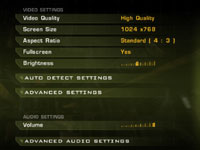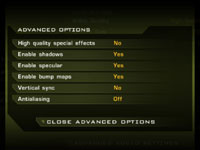CRT Gaming:
For gameplay evaluations on a 24" widescreen monitor, please head straight to our widescreen performance section.Quake 4
Publisher: ActivisionWe used the full retail version of Quake 4 patched to version 1.3.0. It is the fourth game in the Quake series, based on the technically-sound Doom 3 engine. However, unlike Doom 3, we found that the game benefits from at least 2x anti-aliasing, and the experience with anti-aliasing at a slightly lower resolution was better than increasing the resolution with no AA applied.
Both anti-aliasing and anisotropic filtering were controlled from inside the game. When you select "High Quality" mode, 4xAF is automatically enabled, and when the "Ultra Quality" mode is enabled, 8xAF is automatically applied to the scene. We forced anisotropic filtering values via the console using "image_anisotropy".
We did a manual run through from a five minute section of the Nexus Hub Tunnels level and found that a minimum of 15 frames per second and an average of 45-50 frames per second in our test section was deemed to be playable across the rest of the title.


The texture filtering quality on NVIDIA’s hardware was much more refined in this title and we didn’t notice any issues with texture shimmering across a range of levels. In the same vein, we didn’t see much of an improvement when enabling ATI’s high quality anisotropic filtering algorithm. On the positive side for ATI, it seems like Catalyst 6.9 has fixed the stuttering problems we’ve documented in the past.

MSI MPG Velox 100R Chassis Review
October 14 2021 | 15:04











Want to comment? Please log in.